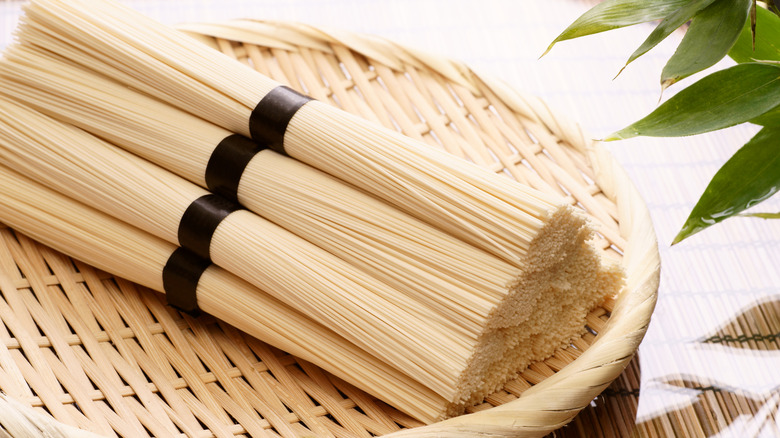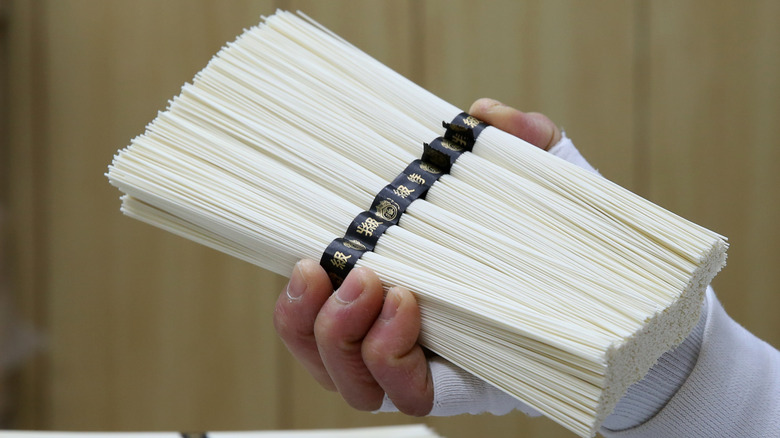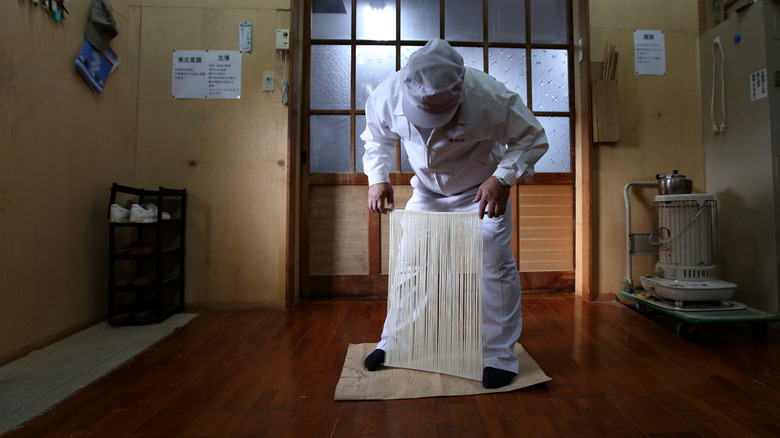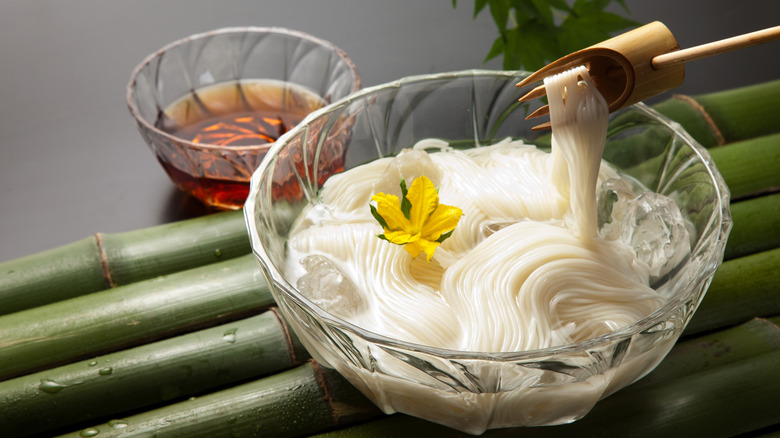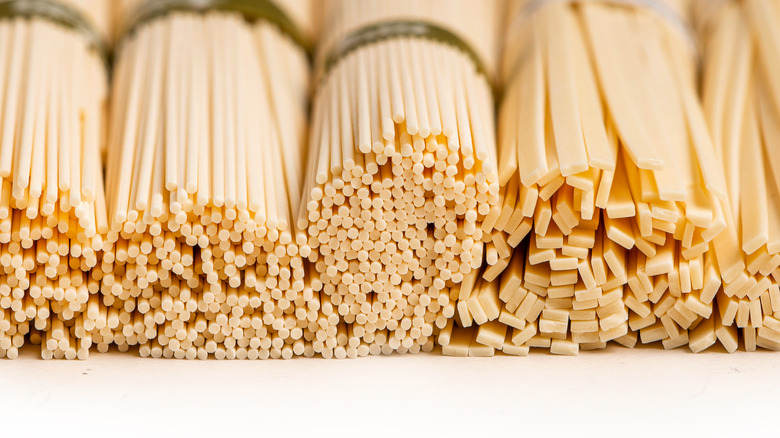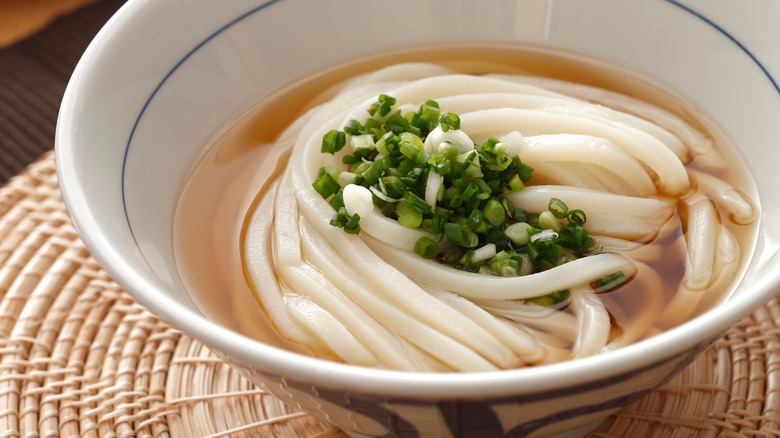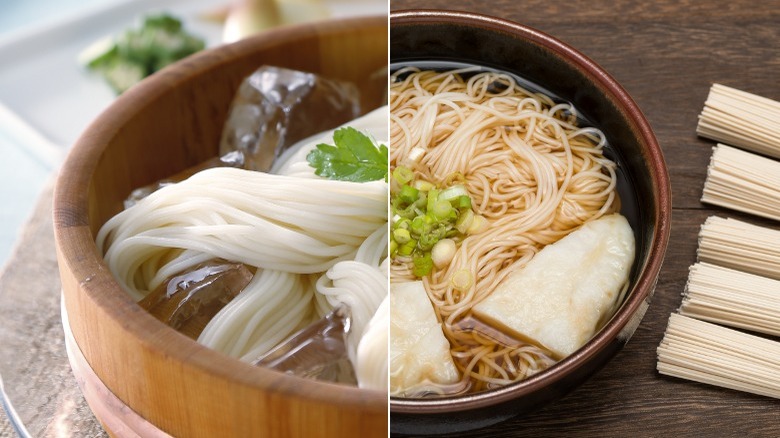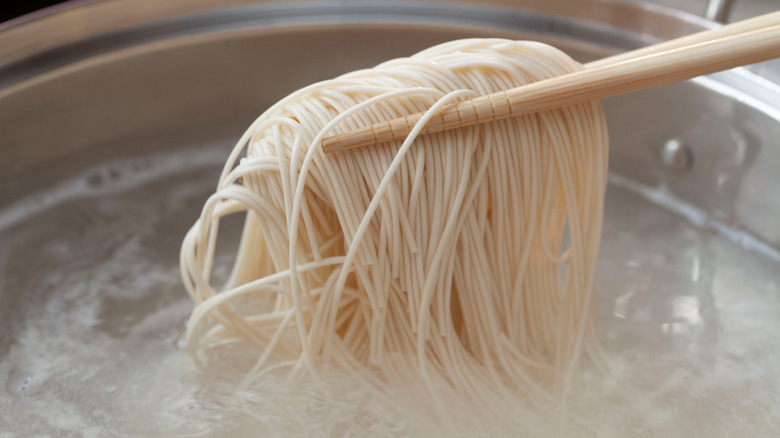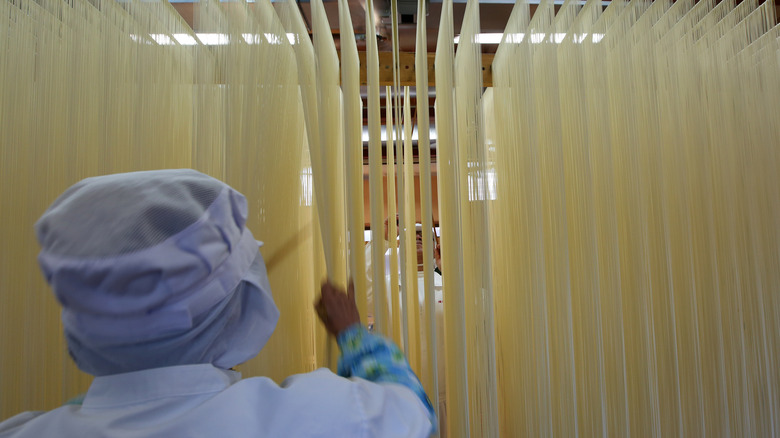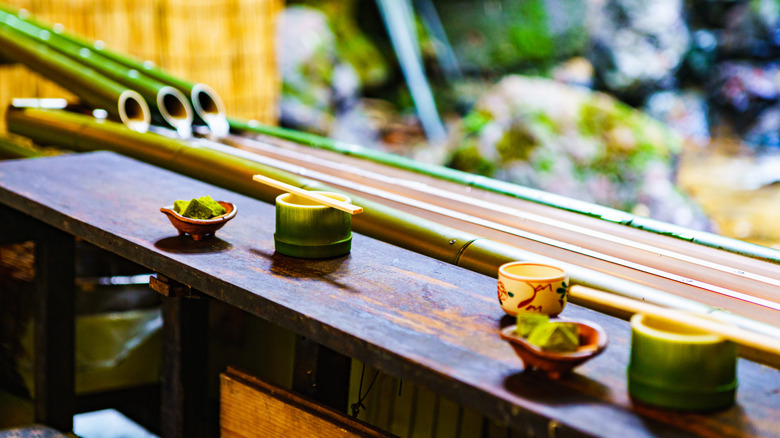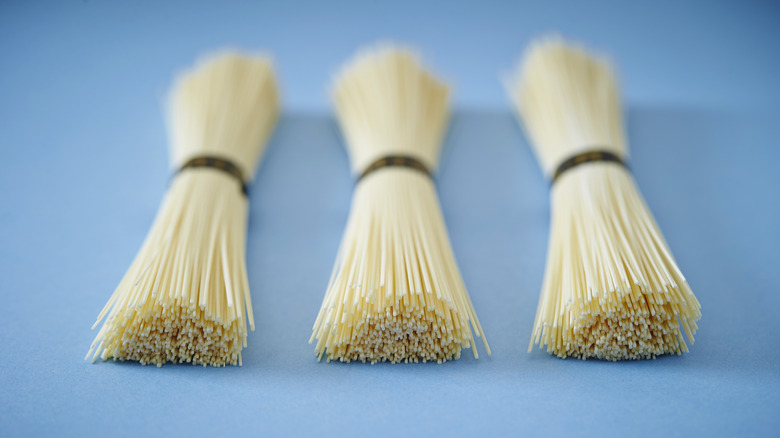Sōmen Are The Japanese Wheat Noodles That Can Be Served Hot Or Cold
Nothing says Japanese summer quite like sōmen noodles. These thin, white wheat noodles are a great way to cool off when served cold, and the dish is enjoyed across the country. This may surprise some foreigners since other types of Japanese noodles, like soba and udon, have been more successful abroad, but sōmen is one of the most popular types of Japanese noodles. Across the country, you can find nagashi sōmen, a style of restaurant where cold sōmen noodles are floated down bamboo chutes for diners to catch with their chopsticks.
The origin of sōmen is only vaguely understood. In the 8th century, there was a period when Japanese emissaries brought back several styles of Chinese noodles to introduce to Japan. Over the next two centuries, Japan would create its own take on the Chinese noodles, resulting in many of the noodles Japan is known for today, including sōmen.
Sōmen noodles are served hot in a soup called nyumen in the winter months, but they are more commonly associated with cold summer dishes. When it's cold out, thicker noodles are simply more popular, at least in Japan. In Korea, sōmen noodles are more regularly used in hot winter dishes. Contemporary Asian-fusion cuisine has also found several ways to incorporate sōmen noodles into new dishes, like sōmen carbonara.
What are sōmen noodles?
Sōmen translates into English as "thin wheat." Sōmen noodles have a diameter of 1.3 millimeters wide or less, making them similar to vermicelli noodles, which are less than 1.5 millimeters wide. This is why sōmen noodles are sometimes called a vermicelli-style wheat noodle. There is another Japanese noodle known as hiyamugi (chilled wheat), which is also served cold and often thought of as a thicker version of sōmen noodles since they have a diameter of 1.3 to 1.7 millimeters.
After their introduction to Japan in the 8th century, sōmen noodles were eaten by Japanese nobility. For many years, the noodles were associated with the Tanabata or Star Festival, a celebration of the gods on the seventh day of the seventh month. Achieving sōmen's characteristically thin size was fairly labor-intensive and time-consuming, meaning that ordinary people weren't able to regularly enjoy the dish until roughly the 1700s.
Different regions are known for their unique styles of sōmen noodles. The Miwa district is known as the birthplace of sōmen, and Miwa sōmen is considered to be a premium style of noodle alongside Banshu sōmen and Shodoshima sōmen.
How are sōmen noodles made?
Each region and each manufacturer has their own unique recipe and process for making sōmen noodles, but good sōmen noodles require lengthy periods of drying interspersed with periods of stretching. sōmen noodles are made from wheat flour, salt, and water. Oil is often used to coat the noodles, though it is not added directly into the dough.
The process begins by kneading together the flour, salt, and water. The dough is then formed into one long noodle known as a mentai noodle strip about four inches wide. Oil is brushed onto the noodle strip before allowing it to ripen or rest for a couple of hours. The noodle goes through a thinning process, followed by more ripening, followed by more thinning until they are the correct size. Traditional sōmen noodles are thinned out by hand, while factory-made sōmen noodles are thinned and dried more quickly with machines.
With so few ingredients, the quality of the product is heavily reliant on the process by which the noodles are thinned. Thinning with long periods of rest creates a better, chewier texture known as koshi.
What do sōmen noodles taste like?
Sōmen noodles are known for their mild flavor and chewy texture. Their mildness makes them incredibly versatile as they readily soak up flavors from broths and other sauces. When eaten cold, sōmen noodles are often dipped in a chilled soy broth known as tsuyu. This gives the noodles an umami punch. Of course, being so mild means that what they taste like is heavily dependent on what dish you are using them in, so opinions may vary.
As an ingredient, sōmen noodles are primarily used to provide texture. Sōmen noodles are more commonly compared by mouthfeel than flavor. There are regions that make their sōmen noodles as small as 0.3 millimeters wide, and the thin, almost gelatinous sensation sōmen noodles provide is what people associate with them. Because sōmen noodles are so small, it would be unusual to eat just one at a time. So, when you grab a mouthful, these very thin noodles become a highly sensory experience as they shoot off in different directions.
Sōmen noodles vs. soba noodles
Soba is another popular type of Japanese noodle that is sometimes confused with sōmen. It doesn't help that their names are so similar or that the packaging for both noodles is hard to distinguish. The primary difference between the noodles is the different flour used. Soba noodles are made with buckwheat flour — though many soba noodles use a combination of buckwheat and wheat flour since pure buckwheat noodles can be brittle. Because of the addition of buckwheat flour, soba noodles have more nutritional value, although the difference will depend on how much buckwheat was used. The buckwheat also gives soba noodles a slightly nutty taste, which lends them a more commanding presence.
Both noodles are considered thin, but sōmen noodles are thinner. Soba noodles are typically around 1.5 millimeters. Because of their size, soba noodles are much more approachable for home chefs looking to make the noodles themselves. The process of thinning out sōmen noodles requires a lot of know-how, equipment, and time, so home chefs are typically limited to store-bought products. Both soba and sōmen noodles can be used in hot and cold dishes. Mori soba is a dish that is nearly identical to how sōmen noodles are prepared in the summertime: chilled and dipped in tsuyu.
Sōmen noodles vs. udon noodles
One of the most popular types of noodles in Japan is udon. These big, chewy noodles are often about ¼ inch thick, though you can also find thinner versions. Udon noodles provide a very different mouthfeel compared to sōmen but, apart from their size, they share a lot of similarities. Both noodles are white since they're made with wheat flour, salt, and water. They're also equally versatile as both are used in hot and cold soups and stir-fry dishes.
Because the only real difference between the two noodles is their size, you can substitute sōmen for udon in nearly any recipe. You won't get the same full-bodied chew, obviously, but it's a great way to bring new life to classic Japanese dishes like kake udon. Of course, once you start making hot sōmen soup, you're getting awfully close to nyumen instead of kake udon with sōmen. But, the fact remains that, despite their difference in size, udon and sōmen have a lot in common.
Hot sōmen vs. cold sōmen
Without a doubt, sōmen is more commonly associated with cold dishes that are perfect for a hot summer day. Because the noodles are so thin, they cook quickly. To keep sōmen noodles from getting too soft, they are taken out of the boiling water and placed in an ice bath to stop them from cooking any longer and keep them al dente.
Their thinness also makes them light on the stomach, meaning that when the sun is beating down on you, you aren't going to feel like you're swallowing a meaty winter noodle. These are light and airy, ideal for a refreshing summer soup.
In the winter, thicker noodles are generally preferred, but sōmen is still eaten hot in the form of nyumen. Like many hot Japanese soups, it's a customizable recipe that starts with dashi (an umami-packed broth) and noodles with an open invitation to include whatever vegetables and protein you have on hand. There are also regional variations on sōmen stir fry, like Abura Zomen from the southern Amami Islands, which uses anchovies to give the dish a fresh seafood twist.
How to cook with sōmen noodles
Cooking with sōmen noodles is super easy. For cold soups, you would traditionally cook the noodles in boiling water for 90 seconds. You'll need an ice bath prepared to put the noodles in to keep them from overcooking. If you don't have an ice bath ready, run cold water over the noodles. Once chilled, the noodles are set out on their own in a bowl over ice. When served, dip the noodles in your chilled tsuyu or another dipping sauce.
For hot soups, the process is similar. You will cook the sōmen noodles on their own in plain water, just as with cold dishes, except you will undercook them since they will continue to cook once placed in the hot broth. Instead of 90 seconds, cook them for only 60 seconds. That's a short window, so be sure to add all of the noodles at once to cook them all equally. Run the noodles under cold water to stop them from continuing to cook until you're ready to place them in the broth with the rest of the ingredients.
You may remember that oil is spread on the outside of the noodles during manufacturing, which many people prefer to wash off. When you are running cold water over the noodle after it has cooked, knead the noodles with your hand to rinse the oil off. This step is optional but preferred.
Where to buy sōmen noodles
It's worth checking the Asian section of your local grocery store for sōmen noodles. They're not as popular as some other types, like udon or soba, but they're common enough that many grocery stores will carry them. If you aren't having any luck, look for a local Asian or Japanese market, which will undoubtedly carry several brands.
You can also shop for sōmen noodles online if there's a particular brand that you're looking for. Are you interested in trying the best sōmen available? Miwa sōmen probably won't be in a brick-and-mortar store near you, but there are many online retailers offering to ship packages of this delicacy to you. There is no shortage of online Asian food markets that are worth looking into. And, if you're shopping in Japan, there will be plenty of sōmen noodle products available. Go wild.
Nutritional information about sōmen noodles
Noodles aren't known for their nutritional value. No one is going to be marketing sōmen noodles as the next superfood anytime soon. But, unless you're on a low-carb diet, they aren't an unhealthy option either.
A typical portion size of sōmen noodles is 60 grams. According to Check Your Food, one sōmen serving will provide you with 214 calories and 44 grams of carbohydrates. They aren't without nutritional value, though. Sōmen noodles have 7 grams of protein and 3 grams of fiber. They're also a moderate source of manganese, selenium, and copper, which all contribute to cell health, as well as a small amount of iron. They do not contain any sugar, and they contain very little fat (only half of a gram).
The small ingredient list will appeal to anyone who prefers knowing exactly what's in their food, and the lack of highly processed ingredients is great for people looking for a more natural diet. If the lack of nutrients is concerning to you, remember that sōmen noodles are there for texture and body. You're free to add whatever superfood vegetables and protein you like to the dish.
How to store sōmen noodles
The shelf life of sōmen noodles will depend on what brand you buy, but some noodles can have a shelf life of up to three years. More likely, an unopened package of dry sōmen noodles will last in a dark, cool cupboard for up to a year before going stale. Unlike fresh udon, sōmen noodles are only available dry. You won't be able to find fresh versions, not even in Japan, since drying is part of the creation process.
Once cooked, you're better off keeping the noodles and broth separate during storage if you want to keep their chewy texture as long as possible. Store them in an airtight container in the fridge for up to three days. If the noodles are already in the broth, go ahead and store them in an airtight container as well. The noodles will likely get soggy but should keep for up to two days.
